
Full on tweed suit – on trend in those days!

Authenticated tweed fabric from Harris must contain this badge or it is not guaranteed Harris tweed
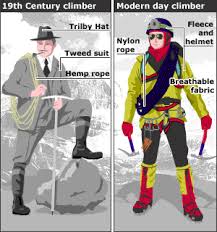
How mountaineering gear has changed through the ages – from tweed to gortex.

Tweed in fashion and accessories as you’ll see today.
A visit to Scotland wouldn’t be complete without catching a glimpse of the ginger-fringed and friendly Highland coo! These lovable and docile creatures are a famous picture-postcard icon of our country, but they’re more than just a pretty face. Being the nature enthusiasts that we are and regularly having the chance to see these beauties roaming freely, we thought we’d answer some regular coo FAQs!
They’re a far cry from the short-haired black and white dairy cow, and that’s because these hardy souls evolved to put up with the wind, rain, snow and sub-zero temperatures that come with living outdoors through a Scottish winter. Though the classic ginger fringed cow is the star of many selfies, they actually come in a variety of colours – blonde, black, brown and a mixture! They have two coats, one longer outer coat to protect them from the elements, and a downy undercoat to keep them cosy. While most cattle would take warm shelter in harsh weather conditions, our highland coos are comfortable setting up for a night in an open shelter (called a fold). Their famous fringe (called a dossan) and long eyelashes protect their eyes from the weather and pesky midges.
Check out VisitScotland’s Coo Cam and say hello to Thelma, Louise, Cairistiona, Breagh and Janima from Kitchen Coos and Ewes in Dumfries and Galloway and Swanston Farm in Edinburgh.
Both male and female highland cows have horns. Although they look intimidating, they’re used to forage for food or to dig through the snow in winter – so a very tough look for a far more innocent use! You can tell a male and female coo apart by their horns. Male horns will generally come out parallel to the ground and turn up or forward slightly at the ends. Females have longer, thinner horns which have much more of an obvious curve.
First recorded in the Scottish Highlands (as early at the sixth century!) – they were named after their origins. Nowadays you can find the Highland Coo dotted all over Scotland, including the islands! VisitScotland have created a handy guide of all the places you might spot a Highland coo as and when COVID restrictions allow, from the northern tip to the borders of the country. Your safest bet would be the Highlands, and for the true rural Scottish wildlife experience we highly recommend setting up base in the Cairngorms and taking a few days to explore. Our Highland Wilderness Trips are famous for sights of deer, rare birds, badgers and of course the gorgeous Highland coo too!
If you’re keen to see a coo our recommendations would be to join us on a visit to Lynbreck Croft (to be included on the Highland Family Adventure and Cairngorm Discovery tours) or check in with Rothiemurchus estate on their coo tours for your rest day activity. There are also coo viewing opportunities when we do to Harris (Western Isles Wilderness), Skye (Superlative Skye), Knoydart (Wild Knoydart) and Torridon (Classic Torridon) – so almost everywhere we go!
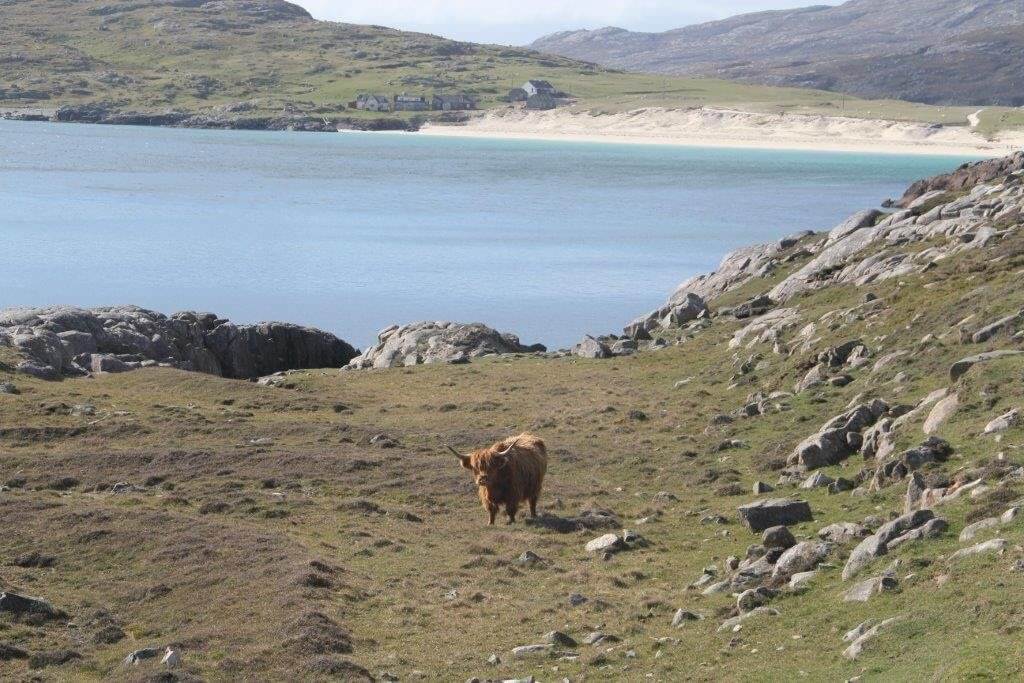
One of the local residents observes the tourists disdainfully from his/her comfy abode.
If you love the Highland Coo/Cow we highly recommend following Lynbreck Croft on Facebook.
Looking back through our photos taken during 2020, it doesn’t seem to have been that bad … but at the time, there were moments.
We’ve put together a wee video of the highlights. Hope you enjoy having a look.
What would your idea of Highland Adventures include? There are all kinds of options available these days. However, walking the hills and woodlands of the iconic Cairngorms National Park is an experience never to be forgotten. Communing with nature and enjoying spectacular hikes and landscapes is a treat for the senses as well as having proven benefits for both mental and physical wellbeing. But do you ever miss a few home comforts? Or wish you could explore a little further or stay a little longer if only you could carry more kit? Walking with pack ponies could be the answer – an ancient activity that could enhance your Highland adventures in unexpected ways. Both walking and riding with pack ponies alongside are activities which have taken place in the Highlands for centuries.
Surely you’ve seen pictures of Queen Victoria (admittedly astride a pony herself) accompanied by pack ponies, exploring her Highland estate at Balmoral. Ponies are still used by some traditional estates in Scotland during the deer season to help bring the deer carcasses off the hill.
Ponies would also have been an important part of life during Outlander times. They’ve always been expected to be working animals here in the Highlands. The breed has been developed to be strong and unflappable; able to carry enormous weights and large for a pony.
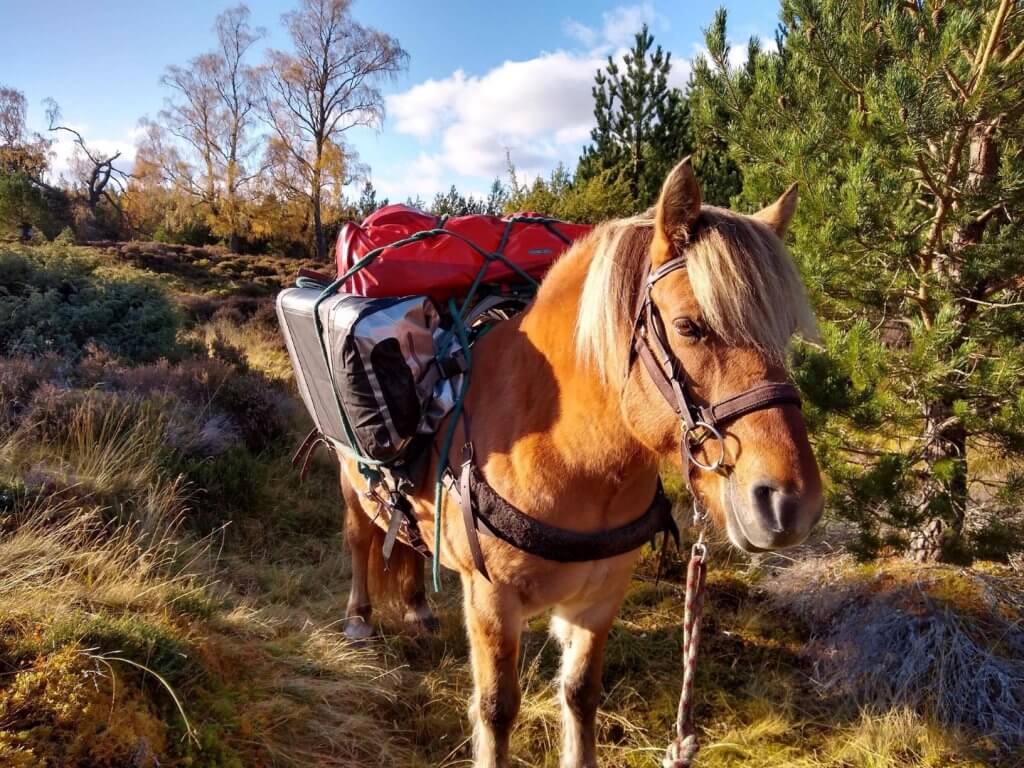
“Their training is quite a long process,” says McLauchlan. “But they have a very quiet temperament and are virtually bombproof.”
We’ll go into more detail in a separate blog but the story in brief is:
We like to hike but both parents on an all day hike and a young child don’t always mix. We looked for a way that we could go on a hiking holiday without having to endure endless complaints from the children. Fortunately, one of our clients had been there before us and mentioned hiking with a donkey (in France). It was a lightbulb moment and led to Andy thinking about how much he could do with Highland ponies instead of donkeys.
Now we are launching our highland adventures: Highland Wilderness Glamping.
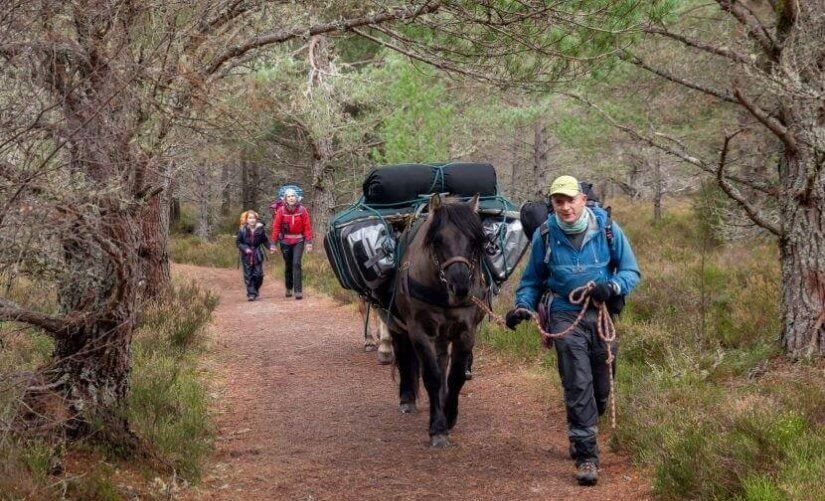
Walking with a pony can be an almost meditative experience – allowing you to slow down, indulge your senses and immerse yourself more deeply in the wildest and most beautiful natural environments
There is a growing field of research that shows that spending time with ponies and horses helps reduce stress and anxiety, as their emotional intelligence quickly creates an emotional bond and calming effect.
With only a day pack you can explore well beyond the normal limits, penetrating deep into isolated terrain, yet still enjoy all the benefits of a fully equipped base at the end of the day, brought to you (and taken away) by the most environmentally-friendly transport in existence
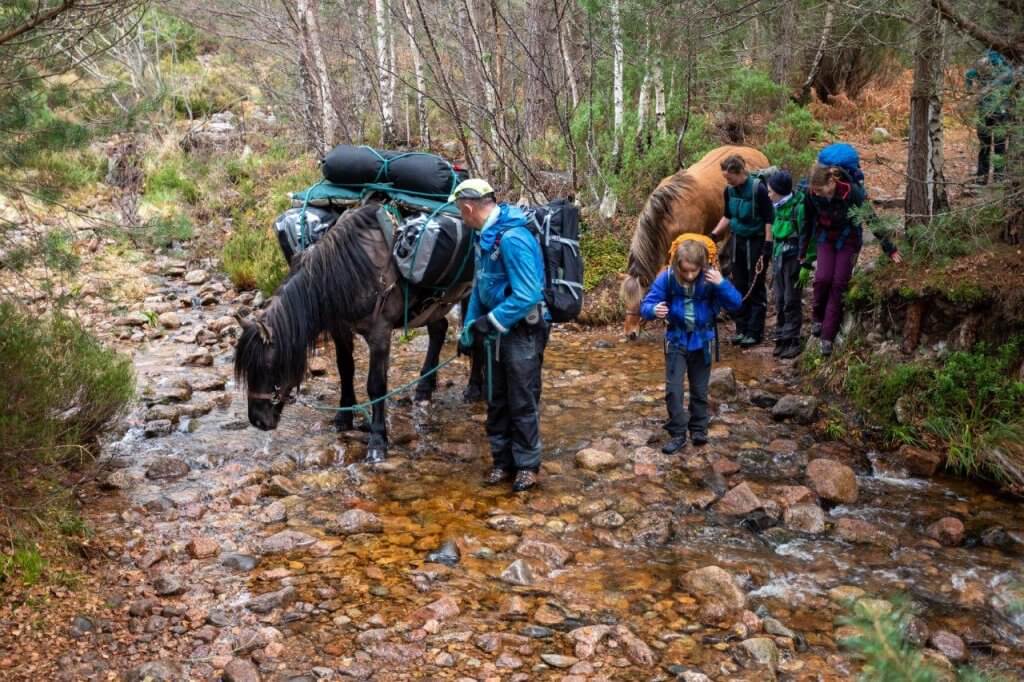
Your equine partners make it possible to bring a few of life’s home comforts to further enhance your experience. Imagine the joy of a sturdy Nordic tipi, warm showers, comfy beds and even a toilet
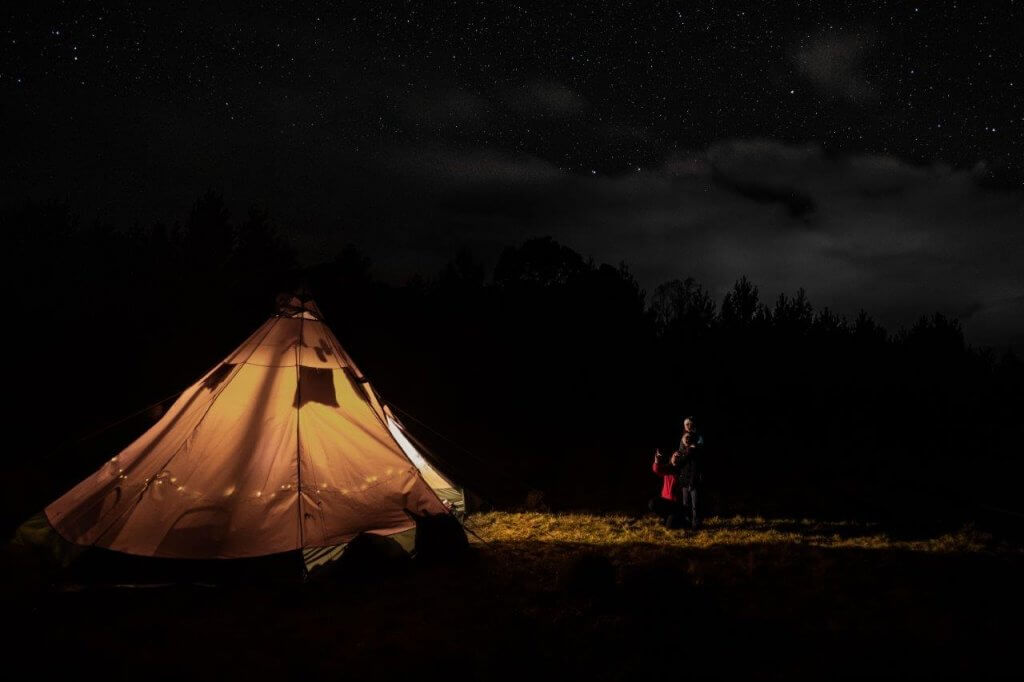
Working together you and the ponies form a team with an intense connection with nature and a genuine appreciation of each other – great company and a great team. Walking with ponies is a traditional pursuit which has incredible relevance to our hectic modern lives. Just imagine slowing down, reconnecting with nature, wild camping, leaving no trace – and yet a warm shower and comfy bed at the end of a satisfying day’s walk.
Best of all, your ponies become your friends. Your kids will be so much more involved in the day and not think of the trip as a “boring” walk at all. They might even get the chance to lead one of the ponies or groom them themselves.
Top Tip: add a packet of extra strong mints to your packing and the ponies will be begging you to be their friend.
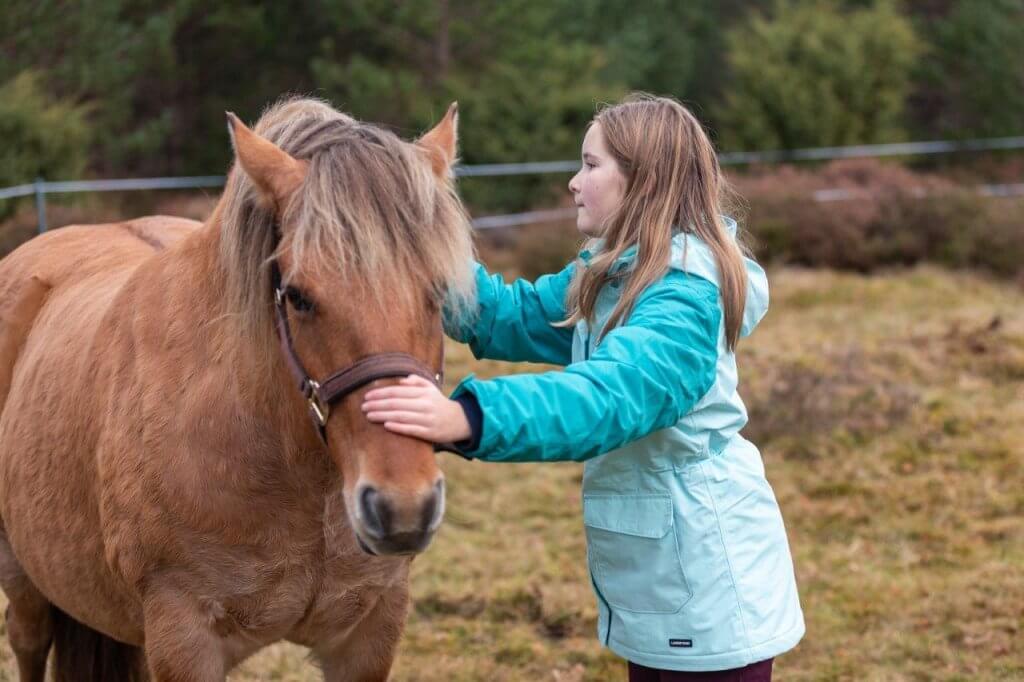
How a pony in the Highlands always beats a quad bike
Deer stalking and the traditional highland pony
Richard Fraser – Scotland’s king of the hill pony
The Highland Pony’s role at work
October was a great time for all autumn walks in Scotland. Our Munro baggers who were able to come up and see us were particularly pleased. We almost lost the opportunity to run a trip for our Torridon group when we weren’t able to go to the accommodation we had booked (due to the household mixing rules which came into place from the Scottish Government) but we were still able to substitute a trip based at Fraoch Lodge.
We also ran 2 Munro bagging trips in mid to late October which were well attended within our COVID19 restrictions.
Of course, with all outdoor activities towards the end of the year, you take your chances with the weather, but I think you’ll agree that we certainly managed to strike it pretty lucky for views and all kinds of points of interest to liven up the walks. Andy even found yet another Cairngorm stone to add to his collection (none have been converted into jewelry yet – hint, hint). This one was even more rare – a green Cairngorm, known as a “Beryl” (pictured below).
To see the full selection of images from the Autumn Munros Bash 2020 (and original sizes) please go to the google album.
Other photos from the whole month are included in the gallery. Please comment or contact us directly if you’d like details of any particular photo.
2020 has been an “interesting” year for those who operate hillwalking holidays. It’s been a time to appreciate our Scot Mountain Holidays family and friends. A time when we’ve been thankful to have so many guests who come back time and again to see us and experience a slice of life in the Highlands of Scotland.
Certainly, for us, this has been a year to appreciate living in the Highlands; enjoying the little things; appreciating the ability to stay in touch with friends and family (even when we can’t see them in person); and thinking about new horizons or opportunities to explore.
There are things to be thankful for, despite the restrictions we’ve been forced to live with this year. Hopefully we’ll also be able to learn some lessons for the future. One thing which has been repeatedly emphasised is that being outdoors significantly reduces the risk of contracting the virus. Many people either discovered or re-discovered the joy of the outdoors and many ways to experience the UK this year – without being in crowded places. Long may it last.
Hillwalking has been the province of the middle-aged, middle-class, white person for some time now. I’ve yet to see figures and demographics for the many people who enjoyed the outdoors this summer (2020) but I hope statistics will show that there has been greater diversity. Certainly the rise in mountain rescue callouts would suggest that there has been a greater influx of newbies.
If you know of anyone who’s been bitten by the bug and wants to get into the outdoors more, bag more Munros, explore year-round – pass on our details – we’re always happy to share years of outdoor experience and can offer foraging tips, navigation refreshers/intro courses and winter skills

Social distancing – before it was an “in” thing to do
Fortunately we have several advantages which have allowed us to continue to run trips through the pandemic (except during strict lockdown phases).
We hope that we’ve managed to strike the right balance for you in providing a safe but social environment for you to come and explore the Highlands. Come and see us when travel is allowed once more.
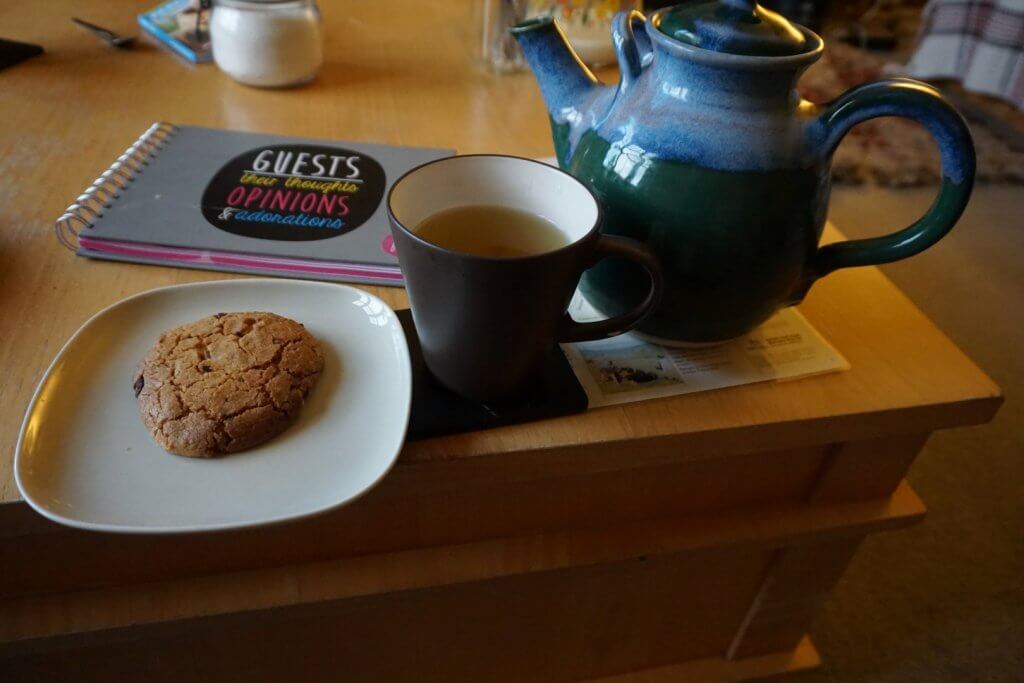
Our temporary advice until COVID is brought under control/defeated is to travel up by car where possible. Alternatively follow all the strictest guidelines on travel and wear a face covering at all times except when eating/drinking.
We hope that movement will be allowed once more for our winter season. Book your visit as soon as you can. There will no doubt be many desperate to get a wee break away from home by the time we’re released once more.
I could say a lot more about how safe it is to come and join us for a hillwalking holiday but really you’d probably be better off asking someone who was able to do just that before #lockdown2 started at the beginning of November. Here are Mala’s recommendations after her trip in September:
“I came to Fraoch Lodge with some nervousness as this was my first holiday on my own. From the moment I met Andy, Rebecca and Gregor, I was made to feel welcome and at ease.
I have had the best week here. I have loved the walks in the Glens, Forests and Lochs (programme) and Andy also kindly threw in a mountain! Through Andy’s knowledge of the environment and geography, I feel as though I have learnt so much about this incredible part of the world.
Rebecca’s cooking has been outstanding. Her inventive, creative cooking, and delicious dishes, and amazing cakes have really been a delight to experience and enjoy. I will miss “Cake o’Clock” and my evening with sage tea & Kindle.
I’ve loved chats and laughs with Gregor. Thank you to you all for making my holiday so special and memorable. Your hospitality and welcome has meant so much. I hope to come back and see you again one day.”
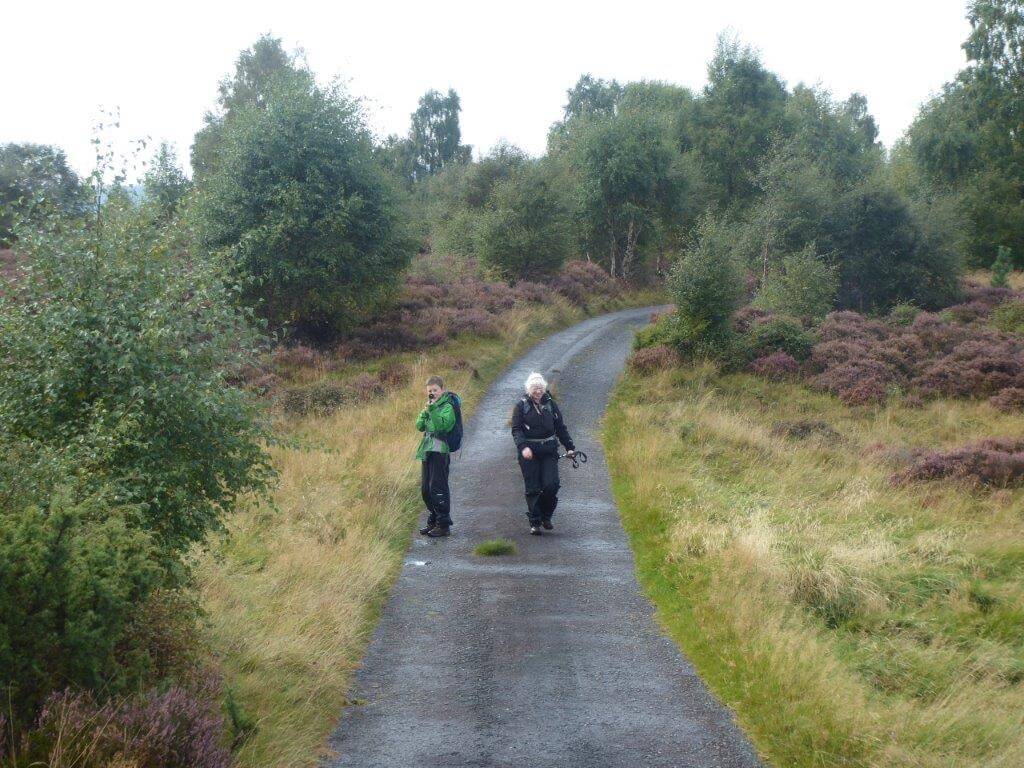
It’s a strange world we’re living in at the moment. Instant access to the “news” and the fast pace of travel have turned against us. The uncertainty facing us all in the light of dramatic reports of everything to do with coronavirus are not helping mental health in any way. Until we can have some more balanced view of the threat to society in general, and our own personal circumstances in particular, we need to develop better coping mechanisms before we are all overwhelmed by fear.
Long term we can not all be confined to our homes but we can practise better hygiene and social distancing hopefully in the future alongside rapid testing and results (not yet available in any meaningful way), so we can return to some social situations. If there were a finite end in site it would help us all to learn to deal with our reality now, but there isn’t – so in the meantime, we need to learn to make our own risk assessments alongside government guidelines and restrictions.
COVID-19 is having a dramatic impact on the whole of society in one form or another. We’re lucky enough to be relatively isolated from the devastating health impact. We live in a remote area with low population but for those of you who live in cities the risk level is much higher.
Here are some tips as we see it to get away from the pandemic:
The single most detrimental factor to my own personal mental health and effectiveness during this period has been news overload. The constant reporting of numbers relating to COVID19 has had the effect of making me terrified to go anywhere or do anything. If I feel like that based in the Highlands and working from home anyway – then how much worse will it be for those who have to be in contact with large numbers of the public. How much worse is it for our public health workers?
Our news reports at the moment are almost exclusively focussed on COVID related issues. Brexit has very much taken a back seat as have reports on crime rates and worries about terrorists. Have they gone away as completely as it seems at the moment? Probably not. It would be interesting to compare news reports across the world. In Africa, it could well be a very different picture. There are after all still other problems worldwide which are of just as much concern if not more. If you live in a country where famine and hunger are very real prospects – how much time do you have to worry about COVID19 as well?
Definitely if you want any chance of getting your head in a better place – get away from the news and media. You’ll find that you will have a more even equilibrium and be able to achieve more positive results. You’ll probably also want to take a break from social media.
Experiment – see if turning it off for a morning is achievable. Increase your time away from the news until you can go a day or a week without checking in. Has that helped you to feel any happier? Have you got more time on your hands to take up new hobbies perhaps? Write that book you’ve been meaning to. Repaint your room. Explore your neighbourhood. Take up geocaching. Set yourself a fitness target … there are so many things you could add to your life which would give it more meaning than obsessing about the media reports and numbers but just be sensible.
We’re all spending a lot more time at home now – working at home, living at home, always at home. If you’re feeling at all stressed, being in the same environment all the time surely won’t help you. It is more important than ever to be able to get away from home, even if it is just to go for a local walk. Getting out for some fresh air, even in the park closest to you, will put you in a much better frame of mind to face the rest of the day.
The hospitality and travel industries have been the big losers in the government efforts to control the spread of coronavirus, but businesses have also made huge efforts to make their premises safe. Where alcohol is not served, these efforts have been more successful and some businesses have been exceptional in their efforts to adapt. Some good local examples in our area are: Anderson’s Restaurant, The Applecross Inn and Nethy House cafe amongst many others.
In fact, the Cairngorms National Park have been leading the way in helping businesses work together to fulfill all Test and Trace obligations with the #CairngormsTogether programme. Guests in the park use a QR code scanner to track which businesses they visit which means the guests, the businesses and their staff are quickly able to trace and isolate any potential infections. In turn this helps to keep the spread of COVID19 as closely controlled as possible. Fraoch Lodge is also part of this programme, though we’ve had very few visitors since March: partly through choice.
Staying away from home will not necessarily increase your risk of catching COVID19 if you follow all the current guidelines.
It’s an accepted fact that crowded, poorly ventilated areas are very high risk for catching COVID19. Fortunately, this in no way describes our working environment (see below).
One of the biggest pluses recently is the renewed interest in exploring the outdoors. Whether it’s camping (responsibly), cycling or hiking, being outdoors is a great way of escaping from stress and COVID19.
Heading into winter is a big worry for the health service and the government. They’re concerned that we’ll all spend more and more time indoors – which is probably true as we all cower away from the cold. However, you can still enjoy the outdoors and not suffer overly from the cold weather.
Take on new skills – book a navigation course
Check out the Wilderness Glamping heated tents – outdoors but warm and comfortable.
If you are forced to spend more time indoors and at home, you could turn to learn a new skill or a language to occupy your mind. Even if you’re on your own, this will help you to stay mentally active. YouTube videos can be great for introducing you to new skills, even if they are at first confusing.
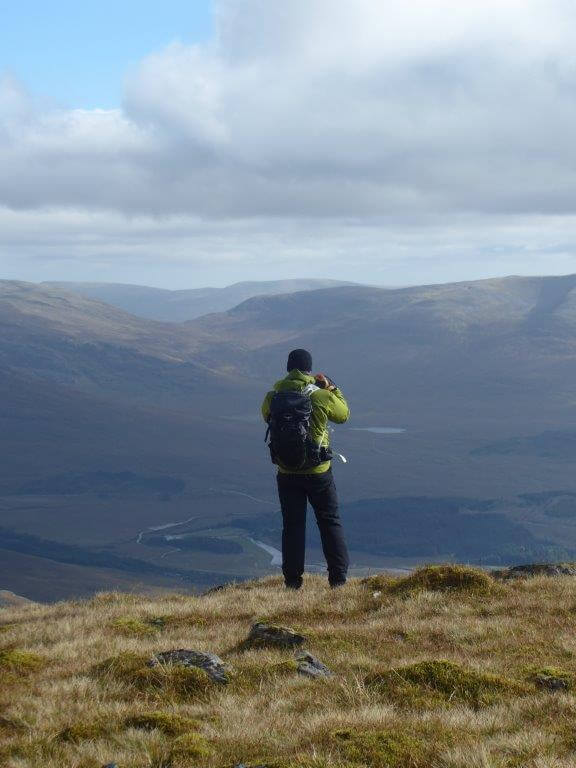
Capturing the view for posterity
Try to make sure that the approach of autumn and winter doesn’t trip you in situations which will create more stress for you. Keep up the new interest in cycling or any other outdoor occupation/activity which has come into your life. If you can, do come and see us and we’ll direct you to some socially distanced and safe walks/activities/food experiences here in the Cairngorms.
In Scotland, there are plenty of walking tours. However, when you join Scot Mountain Holidays – it’s more than just a walk. It’s more of a complete adventure which will hopefully give you a sense of place and belonging. Not only do we feast on stunning mountain views, but we’re also treated to some spectacular, colourful and sometimes dainty looking wild flowers; and unexpected wildlife encounters.
Always bear in mind that September is also harvest month. In normal, times no doubt there would be church services to give thanks. Though we can’t do that this year, we have still been treated to some of the best of nature’s bounty (see images in slideshow).
This year we’ve picked loads of chanterelles and boletus mushrooms plus we’ve been able to find not 1 but 3 cauliflower fungi. It’s also a spectacular year for plums (from the garden) – and apples but they need a wee bit more time on the tree. Berries have been good too. Andy had brought back wild blueberries (blaeberries), wild cranberries (linganberries), juniper berries and cloudberries (highly prized in Scandinavia)
Though wildlife is not the focus of the walks Andy has led this month, he has some close encounters including 2 capercaillie and 2 black grouse down Glenfeshie. Unfortunately no pictures though to back up reports of the sightings.
Of course the dinners we’ve had this month have also been a highlight for everyone, but we’re usually too busy enjoying them to take pictures. We’ll try to add some in next month so you get a more complete picture of the trips and what makes them so special to the people who join us.
Here’s a sample from just this month of all the delights Andy has come across while out in the hills.
With thanks to Mala, Joanne, Valerie, David and Gareth for the excellent company this month.
Getting out and bagging a few more Munros in August is a luxury we haven’t had for a while. It’s fantastic to be able to hill walking in Scotland again and to see some familiar faces enjoying a respectable, socially distanced Munro bagging week based at Fraoch Lodge. These are just a selection of photos taken by Andy and Peter during a glorious week of sunshine and Munros. All were suitably exhausted but satisfied by the time they headed home.
The weather was amazing (as born out by the photos) so we were also able to enhance the trip with some outdoor dining experiences and broke out the BBQ as well which allowed us to be more social than we could have been if stuck indoors.
To see the full selection of images (and original sizes) please go to the google album.
We are so lucky here – wild camping in Scotland is a perfectly legal activity. The Scottish Outdoor Access Code allows us remarkable freedom, but as a result of coronavirus there seems to have been a resurgence in irresponsible access to the outdoors. Lockdown has inspired many to head out into the countryside and enjoy nature; exercise outdoors etc – especially as the gyms have been and remain shut in Scotland for now. Many have turned to so-called wild camping – much of which is a result of people touring in their own motor, caravan and motorhome. Not what we call wild camping. For us, if you’re wild camping you’re unlikely to see any other people at all and you won’t have the luxury of motorised transport.
We’re seeing an increasing number of reports in the local and national press these days about rubbish & fires. All these reports relate to what the press call “wild campers”. Social media is full of images of heaps of rubbish collected by local residents from walks in local beauty spots. It seems that there is an increasing problem with camping equipment being left behind and human waste not being properly disposed of. Of course, this is more of a problem at the moment as public toilets have been slower to open up in this age of coronavirus pandemic.
All this though is not due to “wild camping” in its truest sense. By rights wild camping and roadside camping should not be confused.
To wild camp you must:
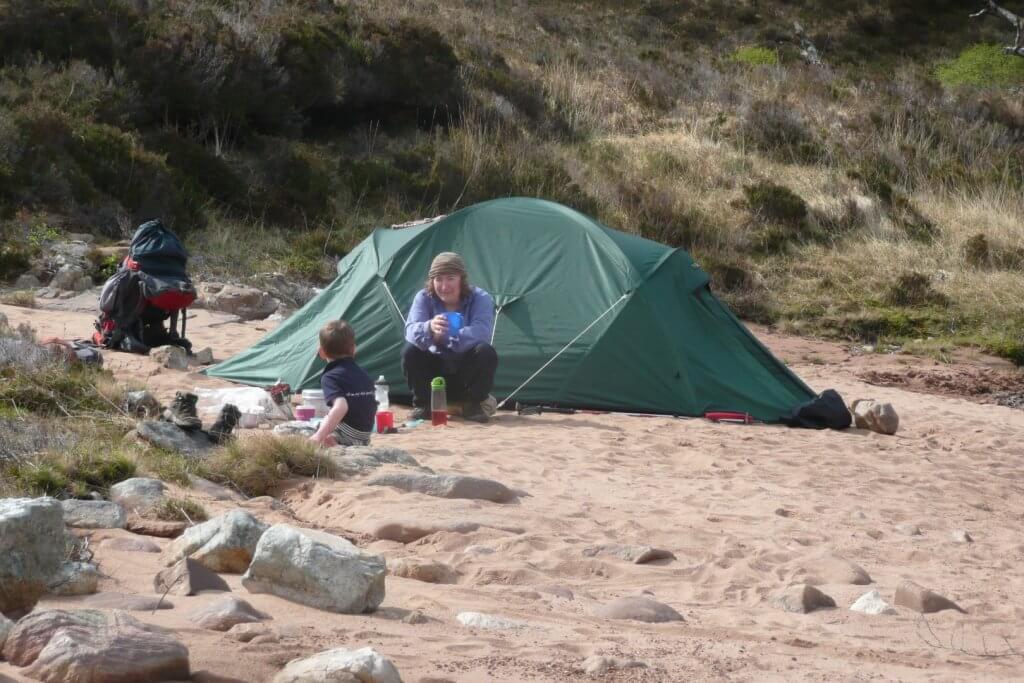
“At Mountaineering Scotland, we continue to promote responsible access and behaviour to our members and the mountaineering community through our communications and campaigns. We believe that the problem is the behaviour, not the activity of camping, and that the creation of additional legislation will not be the solution. The existing legislation already deals with irresponsible and criminal behaviour; what is needed is more investment in low cost facilities, improved public information and councils, communities and police working together to find local management solutions.”
There are no doubt many people who camp close to the road and leave no trace. Unfortunately as per normal, it’s the minority who could spoil it for the rest of us. It is especially important in the time of a hugely infectious pandemic, to make sure that you do not leave any waste behind you. By this I am not referring only to plastic, cardboard etc, but also to any bodily waste. If you’re going to go and camp outside a camp site where public toilet facilities are not available, you need to either take your poo away with you to dispose of properly or bury it in a safe site. If you do not know the protocol, make sure you find out before you leave.
When you work for yourself, from home and your home is your business, it is difficult to get quality time away from work. Our choice is usually to head out for an overnight wild camp – maximum enjoyment for minimum time away. It often feels as if we’ve been away for a week after we come back from an overnight in the hills. The only problem is that we don’t go often enough!
We think it’s such a great way to relax and get away from the stresses of daily life, that we’ve incorporated a luxury version in our programme which you could enjoy too.

We’ve taken the wild camping concept one step further and made it more of a glamping experience. However, we’re still conforming with all the principles of “wild camping” above. No motorised transport; more than 30 minutes walk from a road; self-reliant and independent. Check it out.

Respect a few simple rules or run the risk of losing the right to camp responsibly: check out this article
For a more in depth article covering wild camping across Scotland check out Alex Tiffany’s article on JustgoExploring
Camping – a beginner’s guide by Fiona Outdoors
Wild Camping: Scotland’s top 10 spots
Guide to Wild Camping in Scotland (WatchMeSee)
Visit Scotland guide to Wild Camping
All content © Copyright Scot Mountain Holidays 2025
Responsive web design by Summit Web Solutions